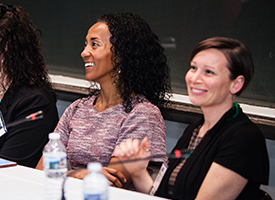
Alumnae Connections
Full Circle
Through new and existing programs, accomplished alumnae of color are returning to campus to connect with and mentor students of color.
By Sarah Achenbach ’88
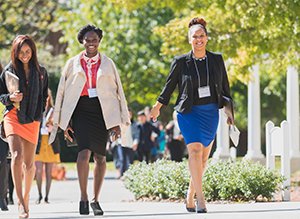
Paris Williams ’18 (far right) at the 2015 C3 event.
Paris Williams ’18 grabs every mentoring, networking, and internship opportunity she can. A dance major with a minor in social justice and plans to earn a Batten Leadership Institute certificate, she has done Hollins’ M.F.A. in Dance summer internship twice, completed a January Term Signature Internship at the D.C. Commission for Arts and Humanities, and created two other internships.
She attends Hollins’ annual Career Connection Conference (C3) to network and learn about alumnae careers, reaches out to alumnae on social media, and chats with them during reunion weekend and other campus events. “Networking is a great experience to meet alums using their liberal arts degrees and finding multiple avenues to create success,” she says.
The most far-reaching connections she’s made in pursuit of her dream—she plans to get a Ph.D. in dance and found a nonprofit for artists of color—are those with other women of color. “Meeting alumnae of color is incredibly motivating and necessary for the students of color,” says Williams, who is applying to Goldsmiths University in London for the M.A. in Applied Anthropology and Community Arts. “Developing informal or formal connections deepens the importance for visibility on and off campus. These connections are the ways we sustain a dialog between the Hollins then, now, and the Hollins we would like to see in 10 years.”
Hollins’ thriving, decades-old internship program, Career Center, and newer programs such as the day-long C3 event, are designed for every student and any career aspiration. Growth in diversity—this year, students of color make up 26 percent of the student body and 19 countries are represented—means expanding networking programs to address the needs of students of color.
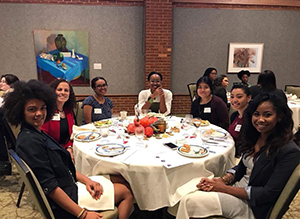
Associate Dean for Cultural and Community Engagement Jeri Suarez (second from left) at the 2017 Network2Careers lunch, also attended by Andolyn Medina ’16 (far right).
Four years ago, Jeri Suarez, associate dean for cultural and community engagement (CCE), founded Network2Careers, which brings back to campus alumnae of color across a range of years and careers to talk with students of color. It’s one of several programs organized through CCE for current and past participants of the 13-year-old Early Transition Program (ETP) for students of color. Suarez runs ETP’s mentoring and community-building programs, a speaker series, and a program designed for international students through the International Student Orientation Program (ISOP).
Williams finds relevance and resonance from Network2Careers. “I love Hollins and the opportunities it’s provided me, but connecting with alumnae of color at C3 is very new and still minimal,” she explains. “Network2Careers is a whole afternoon dedicated to talking, sharing memories, and giving advice specific to the nonwhite experience of being a Hollins student. That time is priceless because it opens up a space for women of color who’ve graduated to connect with one another [and us] and share methods of success being a minority in America.”
Suarez adds, “When you go to a predominately white college, students of color need to know where the resources are, to connect around culture and identity.” She developed the Network2Careers program after receiving a grant from the Virginia Foundation for Independent Colleges. All current and former participants of the ETP are invited to the one-day program, which attracts an average of 20 to 30 students.
Andolyn Medina ’16 has witnessed the growth of Network2Careers from both sides. “The first year [I attended as a student], there was a very small group of us who came,” remarks Medina, who spoke at the 2017 event on October 21 about being in George Washington University’s forensic psychology M.A. program. “This year, to see the students outnumber the alumnae was so exciting. It felt like my soul was full after being there with the students.”
“Network2Careers showed us that we could make it beyond Hollins,” Medina explains. “We knew that there had been women of color before us, but we didn’t see them on campus and wondered what they did. It’s important to see alumnae who look like us.” Much of her graduate work centers on race in forensic psychology, a focus she says was made possible by Hollins’ focus on cultural awareness. “It [provided] the confidence, mentoring, and leadership development to think deeper and contextualize what I experience.”
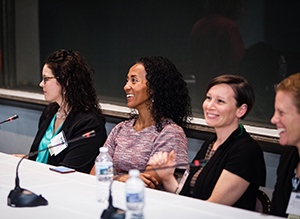
Tamina McMillan ’95 attended the 2017 Network2Careers event and also participated in a C3 panel.
In fall 2017, Network2Careers was held on the Saturday preceding C3, allowing Dr. Tamina Winn McMillan ’95 to participate in both events. It was only the second time she’s returned to campus since graduating. (Blame it on her schedule: The mother of four is also the director of pediatrics at the Nevada Health Center, a community health center in Las Vegas.)
McMillan recalls being the only black premed major during her time at Hollins. Heavily focused on her studies, working two jobs, and fencing competitively, she didn’t participate in career programming: “I had a great group of other students of color who were my support system, but I was just ignorant that there were other resources for me.”
With current Hollins students during C3 and Network2Careers, she shared practical and philosophical wisdom gleaned from experience: Pre-med students should take the MCATs in the fall of senior year, so if they don’t score well, they can retake the test in the spring. And do the things that scare you—growth comes from discomfort. When her CEO offered her the directorship of the Nevada Health Clinic, she said no, assuming she couldn’t do a good job. He kept pressing her, and she’s thrilled with her leadership position.
She speaks a truth for most college-aged young adults, particularly women: “Knowing how to network is not instinctual. It’s important that you see the reality of your dreams sitting before you. To interact with someone who has taken the path is invaluable.”
Suarez heartily concurs: “The key is to embrace the networks around you, for women in general, but clearly for women of color. To watch our alumnae, who are really accomplished in their own fields, come back and mentor our students—and to see those students really learn how to network and connect—brings it full circle.”

Alumnae Board member Antoinette Hillian ’00 participating in a C3 panel in 2015. Laura Mitchell ’20 is a veteran of Network2Careers.
Alumnae Board member Antoinette Hillian ’00, Ph.D., a clinical research specialist at University Hospitals of Cleveland Seidman Cancer Center and past C3 speaker, remembers being one of a handful of students of color in her class and only one of a few science majors regardless of race.
Today, interest among first-year students in majoring in one or more of the sciences is at least as high as the interest in majoring in English. Hollins has a pre-med and pre-vet advising program in place, but the Alumnae Board plans to create a more formal mentoring program for students of color. “Hollins is becoming more aware of the need to support all of its students,” she says. “The whole point of going to a women’s college is that it is a more nurturing and supportive environment, but that means being aware of the needs of various populations, including students of color.”

Laura Mitchell ’20 is a veteran of Network2Careers.
“At the end of the day, it means everything,” says Laura Mitchell ’20, a business and economics double major and veteran of Network2Careers, an ETP peer mentor, and a participant in the first-year internship program. “To be given these opportunities shows that our community does care and value our presence and actively wants to help support us and our endeavors. When there is a clear effort made to afford us all the great programs and opportunities, Hollins feels like home and a safe place we want to be.”
Sarah Achenbach ’88 lives and writes in Baltimore.
![]()
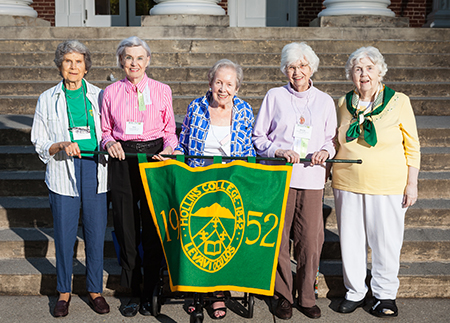
Members of the class of 1952 at last summer’s reunion (from left): Anne Finlay Schenck, Jane Kelly Baugh, Betty Greear Cauthen, Beverly Doolittle Stafford, and Joan Ripple Clark. Not shown but also attending the reunion was Emily Morgan ’79, whose mother, the late Honoria Wilson Morgan, was a ’52 alumna. Morgan says, “It was an honor to be with these women during reunion. With a graduating class of approximately 60, I came to know many of my mother’s classmates, as I grew up hearing about them, and in many instances came to reunion and celebrated milestones with them. This 65th was very special.”
Paris Redux
Paris II reunion renews love for City of Light
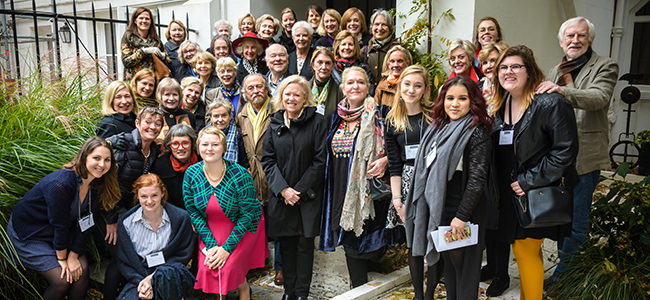
More than a year in planning, “Hollins Abroad Paris II: Paris Today!”, with 31 participants, took place during the week of October 20-27, 2017. A two-day French language immersion session, complete with improv workshops to bring back latent language skills, preceded the week’s events. A motivated and enthusiastic group of Hollins Abroad–Paris alumnae worked closely with Hollins program director Audrey Stavrevitch to create a trip that included venues not on the typical travel itinerary. The goal was to highlight and promote the distinctiveness of the Hollins Abroad–Paris program, now in its 62nd year. Daily sessions on topics ranging from “French Culture and Cuisine” to “Women in France” featured guest speakers, authors, and walking tours. Highlights included a special session with Anne Sebba, author of Les Parisiennes: How Paris Women Lived, Loved and Died in the 1940s, and a VIP tour of the private collection of Emile Hermès. The trip was capped off by a farewell dinner at the Georges, the restaurant located on the rooftop of Le Centre Pompidou.
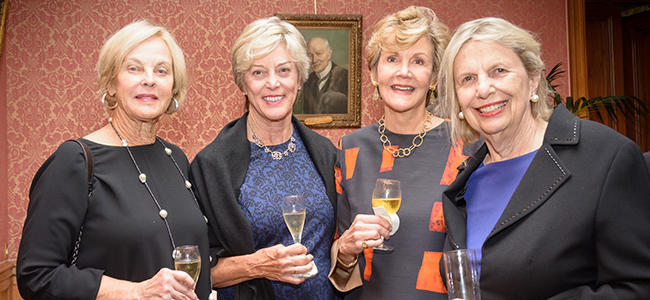
Sue Barth Dobbs ’63; Baruch’s guest Linda Clark; Clark Hooper Baruch ’68; and Wyndham Robertson ’58.
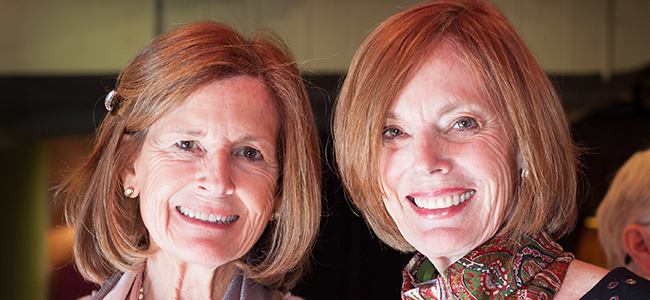
Patricia Thrower Barmeyer ’68 and Bebeb Thrower MacCary ’63.
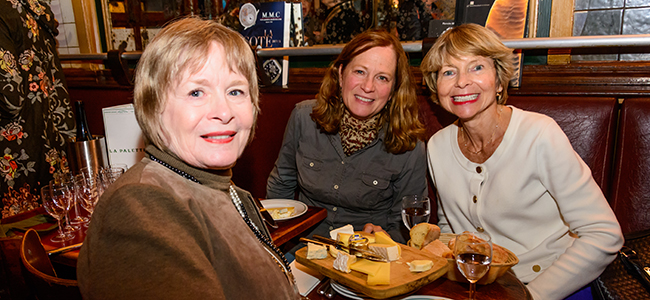
Beryl “Berry” Powers Robison ’61, Barrie Da Parma Kerper ’81, and Marcia “Missy” Van Buren-Brown ’76.
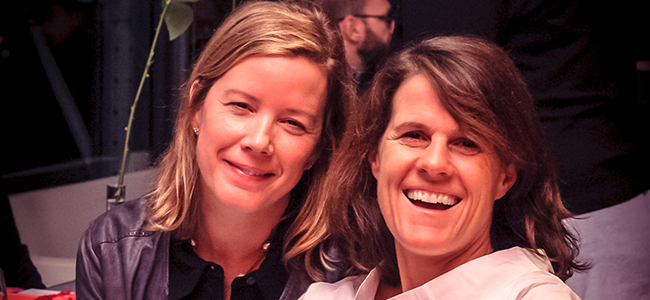
Sully Amos and Peyton Page Wills ’92.
